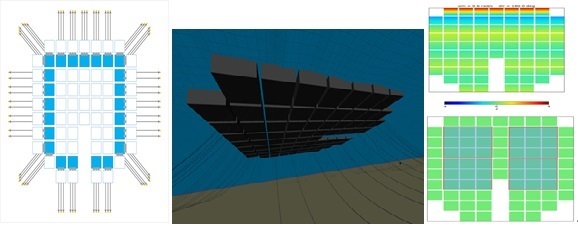Milestone reached: Mooring system design is completed
One of the objectives of the Work Package 3 is to design and engineer a dedicated mooring system for the modular platform concept that can flexibly and efficiently cope with the platform imposed mooring forces. As the platform can be of arbitrary shape, the mooring system has to be developed modular and flexible. Furthermore, the island can vary in size in time, this should be considered in the mooring design.
The feasibility of network mooring for coupled floaters was analysed with the aNySIM tool on the basis of two different business cases defined within the Space@Sea project (North Sea and Mediterranean Sea). The aNySIM tool was updated for larger number of floating objects in the analysis of station keeping capabilities of selected mooring concepts.
The mooring system design was split up into a number of design phases. A first phase applied heuristic and simplified estimates for a rapid initial screening of horizontal load levels on the islands at low computational costs. The results stressed the importance of the global width of the island and the relation with the modularity objective of the work package.
The screening phase revealed feasibility issues for the North Sea business case and resulted into a mooring system candidate for the Mediterranean Sea business case.
In the simulation phase the software tool aNySIM was applied to analyse the mooring system candidate for the Mediterranean Sea. To reduce the computational costs involved with multi-body simulations, the set of simulations was first run for an island platform with individual modules combined into an equivalent single body. A restricted, final, set of simulations was run with all island modules modelled individually. Reduced wave frequency motions were found by clustering of individual modules into rigidly coupled groups of modules
The mooring system design for the Mediterranean Sea resulted in a catenary based solution requiring large diameter chains with three mooring legs attached to dedicated mooring modules. The results of the mooring analysis were applied to design an anchor pile solution and associated installation method.


